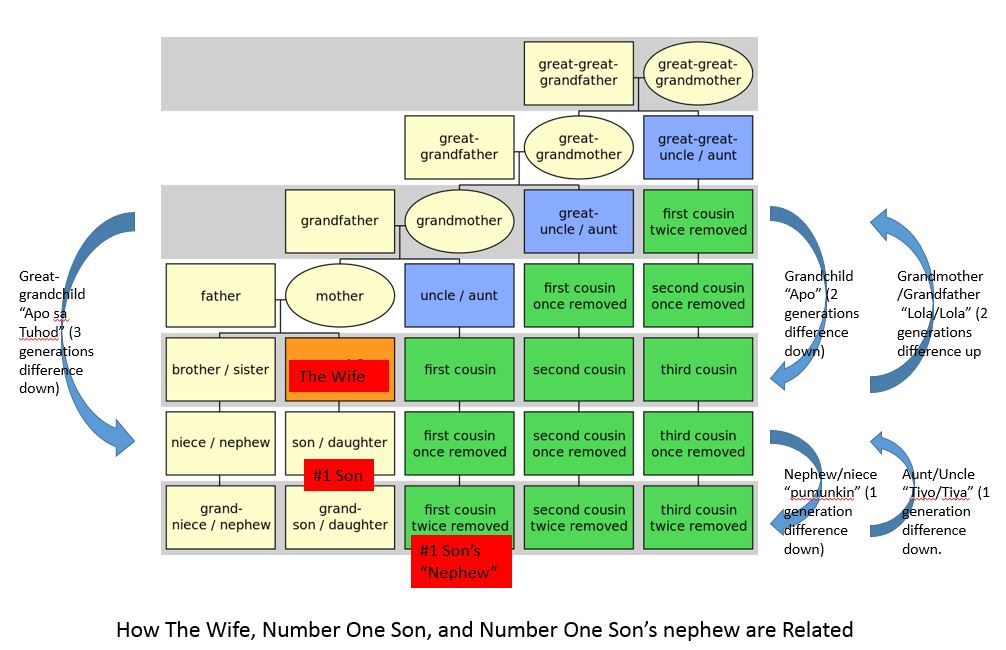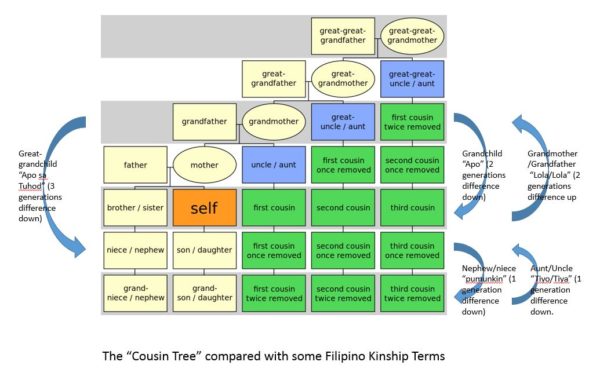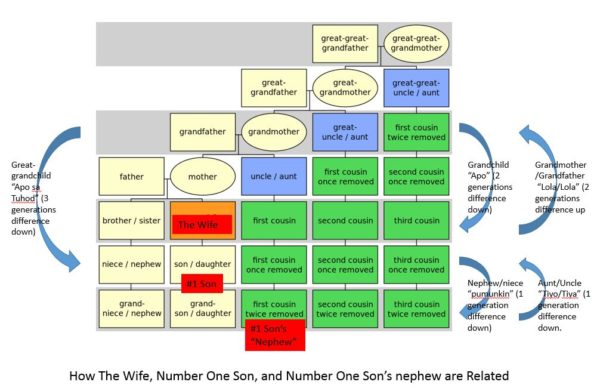Number One Son has a “nephew” who is also a college student in Boston. When I mentioned this to my brother, he couldn’t understand how Number One Son could be the “uncle” of someone who is the same age and who is neither his son nor the son of The Wife’s siblings. I told him “uncle” is the English translation of a Filipino term for a male who is one less generation away from a common ancestor than the other person being referenced. My explanation, while totally correct, totally failed to make him understand. If you are curious how my son can be an “uncle” or are wondering why Filipinos sometimes call each other by weird names like “kuya,” “manong,” or “ading” instead of their regular names, this article by Myles Garcia can explain.
Garcia says that kinship names refers to levels. To the cousin tree picture from Wikipedia, I have added a few lines and names pointing out the level differences, the Filipino names for those relationships, and the English translations. As you can see in the diagram above, one level difference results in “Uncle/Aunt” and “niece/nephew” relationships. Two level differences result in “grandparent” and “grandchild” relationships.
In the case of Number One Son and his “nephew” of the same age, Number One Son’s mother (The Wife) is the first cousin of the grandmother of his “nephew.” Since there is one generation difference from their common ancestors (The Wife’s grandfather and grandmother), Number One Son is an “uncle” to his second cousin once removed (“nephew”). I show this in the diagram below. In addition, The Wife and could consider Number One Son’s nephew as our “apo” or grandchild because of the two levels of difference. I usually do not, though, as that makes us feel really really old!
Clearly the Filipino equivalents do not directly translate to English. My background in Computer Science makes me like the Filipino terminology better – there are names for the relationship between any two people with a common ancestor separated by some n generations, with terms depending on the direction of the difference and sometimes gender. One usually doesn’t get past three generations, but for four or more there are terms I had never heard of before this article, like “apo sa tuhod” (knee) for the fourth generation or “apo sa talampakan” (sole) for the fifth.
Other kinship terms are more familiar to me like “kuya” for older brother or “ate” for older sister. An interesting fact from the article is that the some of these terms come from Chinese and Japanese. Kuya comes from the Chinese ordinal Co, and means the oldest son. The oldest son is “kuya,” the second is “diko”, and the third is “sangko.” So when I call my sons here Number One Son and Number Two Son in the manner of Charlie Chan, to my surprise this movie reference actually has some resonance with Filipino kinship names. In addition, I always thought that the terms manong and manang (for older brother or sister) were Ilocano in origin, but they are actually derived from Spanish for siblings (“hermano” and “hermana”), and now sometimes used for early 20th century Filipinos, as in the Delano Manongs.
Do younger Filipino American generations still use these terms? The Daughter insists that Number One Son and Number Two Son call her “Ate” and not her name and they comply. Number Two Son doesn’t call his older brother “kuya” though. Sometimes Filipino terms of endearment just sound funny in English. A young girl might be affectionately called “nene” and a young boy might be “toto,” again derived from Chinese. I knew a pair of siblings whose parents used those terms, and they would mockingly call each other “Hawaiian Goose” (a nene) or “little dog” (“Toto“). I am glad that they didn’t know what the Chinese origins mean (“the dull one” and “the foolish one” respectively, according to Garcia).
What adds to the fun is that these terms get used for people outside of direct blood relations. A coworker might be called “kuya” or “ate” while close family friends might be “tito” or “tita” (“uncle” or “aunt” from Spanish), or Auntie or Uncle (like in Hawaiian and other cultures). Still, I think that in some ways the Filipino terms are easier than the English ones, especially once the whole “cousin once removed” naming. Since the same terms are used for the mother and father’s sides of relatives, it definitely is easier than Chinese kinship terms (check out this video) which differ along maternal and paternal lineage. If you find this discussion interesting, check out the article – it has even more interesting, surprising, and amusing information about Filipino terms of kinship and endearment.









